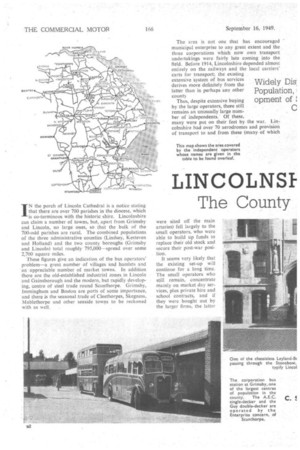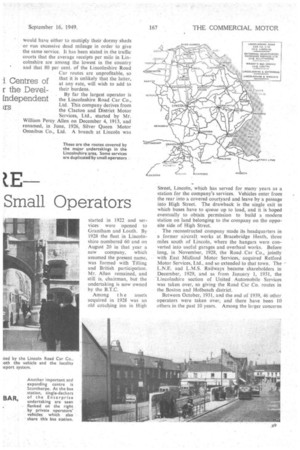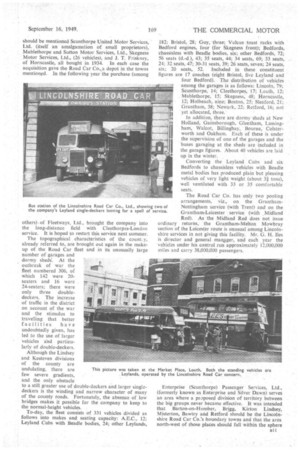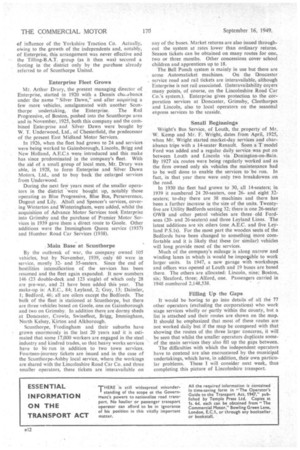LINCOLNSF
Page 42

Page 43

Page 45

Page 46

If you've noticed an error in this article please click here to report it so we can fix it.
The County Small Operators
IN the porch of Lincoln Cathedral is a notice stating that there are over 700 parishes in the diocese, which is co-terminous with the historic shire. Lincolnshire can claim a number of towns, but, apart from Grimsby and Lincoln, no large ones, so that the bulk of the 700-odd parishes are rural. The combined populations of the three administrative counties (Lindsey, Kesteven and Holland) and the two county boroughs (Grimsby and Lincoln) total roughly 795,000—spread over some 2,700 square miles.
These figures give an indication of the bus operators' problem—a great number of villages and hamlets and an appreciable number of market towns. In addition there are the old-established industrial zones in Lincoln and Gainsborough and the modern, but rapidly developing, centre of steel trade round Scunthorpe. Grimsby, Immingham and Boston are ports of some importance, and there is the seasonal trade of Cleethorpes, Skegness, Mablethorpe and other seaside towns to be reckoned with as well. .
The area is not one that has encouraged municipal enterprise to any great extent and the three corporations which now own transport undertakings were fairly late corning into the field. Before 1914, Lincolnshire depended almost entirely on the railways and the local carriers' carts for .transport; the existing
extensive "system of bus services derives more definitely from the latter than in perhaps any other county Thus, despite extensive buying by the large operators, there still remains an unusually large num ber of independents. Of these, many were put on their feet by the war. Lincohishire had over 70 aerodromes and provision of transport to and from these (many of which
Widely Dis; Population, opment of
were sited off the main arteries) fell largely to the small operators, who were able to build up funds to replace their old stock and secure their post-war position.
It seems very likely that the existing set-up will continue for a long time. The small operators who still remain, concentrate mainly on market day services, plus private hire and school contracts, and if they were bought out by the larger firms, the latter
would have either to multiply their dormy sheds or run excessive dead mileage in order to give the same service. It has been stated in the traffic courts that the average receipts per mile in Lincolnshire are among the lowest in the country and that 80 per cent. of the Lincolnshire Road Car routes are unprofitable, so that it is unlikely that the latter, at any rate, will wish to add to their burdens.
By far the largest operator is the Lincolnshire Road Car Co., Ltd. This company derives from the Clacton and District Motor Services, Ltd., started by Mr. William Percy Allen on December 4, 1913, and renamed, in June, 1926, Silver Queen Motor Omnibus Co., Ltd. A branch at Lincoln was
Centres of r the DevelEndependent )rs
started in 1922 and services were opened to Grantham and Louth. By 1928 the fleet in Lincolnshire numbered 60 and on August 20 in that year a new company, which assumed the present name, was formed with Tilling and British participation. Mr. Allen remained, and still is, chairman, but the undertaking is now owned by the B.T.C.
Among t h e assets acquired in 1928 was an old coaching inn in High
Street, Lincoln, which has served for many years as a station for the company's services. Vehicles enter from the rear into a covered courtyard and leave by a passage into High Street. The drawback is the single exit in which buses have to queue up to load, and it is hoped eventually to obtain permission to build a modern station on land belonging to the company on the opposite side of High Street.
The reconstructed company made its headquarters in a former aircraft works at Bracebridge Heath, three miles south of Lincoln, where the hangars were converted into useful garages and overhaul works. Before long, in November, 1928, the Road .Car Co., jointly with East Midland Motor Services, acquired Retford Motor Services, Ltd., and so extended to that town. The L.N.E. and L.M.S. Railways became shareholders in December, 1929, and as from January 1, 1931, the Lincolnshire section of United Automobile Services was taken over, so giving the Road Car Co. routes in the Boston and Holbeach district.
Between October, 1931, and the end of 1939, 46 other operators were taken over, and there have been 10 others in the past 10 years. Among the larger concerns
should be mentioned Scunthorpe United Motor Services, Ltd. (itself an amalgamation of small proprietors), Mablethorpe and Sutton Motor Services, Ltd., Skegness Motor Services, Ltd., (26 vehicles), and J. T. Friskney, of Horncastle, all bought in 1934. In each case the acquisition gave the Road Car Co, a depot in the towns mentioned. In the following year the purchase (among others) • of Fleetways, Ltd., brought the company into the long-distance field with Cleethorpes-London service. It is hoped to restart this service next summer.
The topographical characteristics of the count. y, already referred to, are brought out again in the makeup of the Road Car fleet and in its unusually large number of garages and dorrny sheds'. At the outbreak of war the fleet numbered 306, of which 142 were 20Seaters and 16 were 24-seaters; there were only three doubledeckers. The increase of traffic in the district on account of the war and the stimulus to travelling that better facilities have undoubtedly given, has led to the use of larger vehicles and particularly of double-deckers.
Although the Lindsey and Kesteven divisions of the county are undulating, there are few severe gradients, and the only obstacle to a still greater use of double-deckers and larger singledeckers is the winding and narrow character of many of the county roads. Fortunately, the absence of low bridges makes it possible for the company to keep to the normal-height vehicles.
To-day, the fleet consists of 331 vehicles divided as follows into makes and seating capacity: A.E.C., 12; Leyland Cubs with Beadle bodies, 24; other Leylands,
.182; Bristol; 28; Guy, three; Vulcan toast racks with Bedford engines, four (for Skegness front); Bedfords, chassisless with Beadle bodies, six; other Bedfords, 72; 56 seats (d.-d ), 43; 35 seats, 44; 34 seats, 69; 33 seats, 24; 32 seats, 47; 30-31 seats, 39; 26 seats, seven; 24 seats, six; 20 seats, 52. Included in these constituent figures are 17 coaches (eight Bristol, five Leyland and four Bedford). The distribution of vehicles among the garages is as follows: Lincoln, 79; Scunthorpe, 14; Cleethorpes, 17; Louth, 12; Mablethorpe, 15; Skegness, 48; Horncastle, 12; Holbeach, nine; Boston, 25; Sleaford, 21.; Grantham, 38; Newark, 22; Retford, 16; not yet allocated, three.'
In addition, there are dorrny sheds at New Holland, Gainsborough, Glentham, Lassingham, Walcot, Billinghay, Bourne, Colsterworth and Oakham. Each of these is under the supervision of one of the garages and the buses garaging at the sheds are included in the garage figures. About 40 vehicles are laid up in the winter.
Converting the Leyland Cubs and six Bedfords to ehassisless vehicles with Beadle metal bodies has produced plain but pleasing vehicles of very light weight (about 31 tons), well ventilated with 33 or 35 comfortable seats.
The Road Car Co. has only two pooling arrangements, viz., on the GranthamNottingham service (with Trent) and on the Grantham-Leicester service (with Midland Red). As the Midland Red does not issue ordinary returns, the Grantham-Melton Mowbray section of the Leicester route is unusual among Lincolnshire services in not giving this facility. Mr. G. H. Iles is director and general manger, and each year the vehicles under his control run approximately 12,000,000 miles and carry 38,000,000 passengers.
Enterprise (Scunthorpe) Passenger Services, Ltd., (formerly known as Enterprise and Silver Dawn) serves an area where a proposed division of territory between the big groups never became effective. It was intended that Barton-on-Humber, Brigg, Kit ton Lindsey, Misterton, Bawtry and Retford should be the Lincolnshire Road Car Co.'s boundary towns and that the area north-west of those places should fall within the sphere of influence of the Yorkshire Traction Co. Actually, nixing to the growth of the independents and, notably, of Enterprise, this-arrangement was never effective and the Tilling-B.A.T. group (as it then was) secured a footing in the district only by the purchase already referred to of Scunthorpe United.
Enterprise Fleet Grows
Mr. Arthur Drury, the present managing director of Enterprise, started in 1920 with a Dennis cha,a banes under the name "Silver Dawn," and after acquiring a few more vehicles, amalgamated with another Scunthorpe undertaking, the Enterprise. The Red Progressive, of Boston, pushed into the Scunthorpe area and in November, 1925, both this company and the combined Enterprise and Silver Dawn were bought by W. T. Underwood, Ltd., of Chesterfield, the predecessor of the present East Midland Motor Services.
In 1926, when the fleet had grown to 24 and services were being worked to Gainsborough, Lincoln, Brigg and New Holland, A.E.C.s were introduced and this make has since predominated in the company's fleet. With the aid of a small group of local men, Mr. Drury was able, in 1928, to form Enterprise and Silver Dawn Motors, Ltd., and to buy back the enlarged services from Underwood.
During the next few years most of the smaller operators in the district Were bought up, notably those operating as Blue Progressive, Blue Bus, Perseverence, Dugout and Lily. Altoft and Spencer's services, covering Winterton and Winteringham, were added, whilst the acquisition of Advance Motor Services took Enterprise into Grimsby and the purchase of Premier Motor Services in 1939 gave them a direct route to Goole. Other additions were the Immingham Queen service (1937) and Humber Road Car Services (1938).
Main Base at Scunthorpe
By the outbreak of war, the company owned 105 vehicles, but by November, 1939, only 60 were in service, mostly 32and 35-seaters. Since the end of hostilities intensification of the services has been resumed and the fleet again expanded. It now numbers 146 (23 double-deck and 123 single) of which only 28 are pre-war, and 21 have been added this year. The make-up is: A.E.C., 84; Leyland, 2; Guy, 13; Daimler, 1; Bedford, 46; all are oilers except the Bedfords. The bulk of the fleet is stationed at Scunthorpe, but there are three vehicles based on Goole, one on Gainsborough and two on Grimsby. In addition there are dormy sheds at Doncaster, Crowle, Swinefleet, Brigg, Immingham, North Kelsey, Kirton and Alkborough.
Scunthorpe, Frodingham and their suburbs have grown enormously in the last 20 years and it is estimated that some 17,000 workers are engaged in the steel industry and kindred trades, so that heavy works services have to lie run in addition to two town services. Fourteen-journey tickets are issued and in the case of the Scunthorpe-Ashby local service, where the workings are shared with the Lincolnshire Road Car Co, and three smaller operators, these tickets are interavailable on any of the buses. Market returns are also issued throughout the system at rates lower than ordinary returns. Season tickets can be obtained on many routes for one, two or three months. Other concessions cover school children and apprentices up to 18.
The Bell Punch system is mainly in use but there are some Automaticket machines. On the Doncaster strvice road and rail tickets are interavailable, although Enterprise is not rail associated. (Interavailability covers many points, of course, on the Lincolnshire Road Car Co.'s system.). Enterprise gives protection to the corporation services at Doncaster, Grimsby, Cleethorpes and Lincoln, also to local operators on the seasonal express services to the seaside.
Small Beginnings
Wright's Bus Service, of Louth, the property of Mr. W. Kemp and Mr. F. Wright, dates from April, 1925, when Mr. Wright started market-day services and charabancs trips with a 14-seater Renault, Soon a T model Ford was added and a regular daily service was put on between Louth and Lincoln via Donington-on-Bain. By 1927 six routes were being regularly worked and as the firm owned only six vehicles the maintenance had to be well done to enable the services to be run. In fact, in that year there were only two breakdowns on the road.
In 1930 the fleet had grown to 30, all 14-seaters; in 1939 it numbered 24 20-seaters, one 26and eight 32seaters; 'to-day there are 38 machines and there has been a further increase in the size of the units. Twentyfive are Utility Bedfords seating 32; there is one 26-seater OWB and other petrol vehicles are three old Fordsons (20and 26-seatersj and three Leyland Lions. The latest additions are six oilers (one A.E.C. and five Leyland P.S.1s). For the mast part the wooden seats of the Bedfords have been changed to something more comfortable and it is likely that these (or similar) vehicles will long provide most of the services.
Much of the company's mileage is along narrow and winding lanes in which is would be impovible to work larger units. In 1947, a new garage with workshops and offices was opened at Louth and 19 buses are based there. The others are allocated: Lincoln, nine; Boston, six; Sleaford, three; Alford, one. Passengers carried in 1948 numbered 2,148,538.
Filling Up the Gaps It would be boring to go into details of all the 77 other operators (excluding the corporations) who work stage services wholly or partly within the county, but a list is attached and their routes are shown on the map. It should be emphasized that most of these routes are not worked daily but if the map be compared with that showing the routes of the three larger concerns, it will be seen that whilst the smaller operators duplicate someof the main services they also fill up the gaps between.
The difficulties with which the independent operators have to contend are also encountered by the municipal undertakings, which have, in addition, their own particular problems. These I will consider next week, thus completing this picture of Lincolnshire transport.




















































































